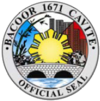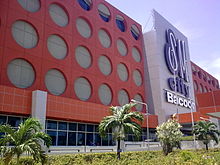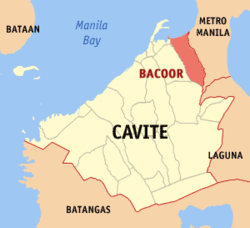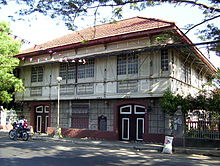- Bacoor, Cavite
-
Municipality of Bacoor
Bayan ng Bacoor— Municipality — 
SealNickname(s): Cavite's Gateway To The Metropolis Motto: Bacoor Cityhood, Now Na! (Bacoor Cityhood, Now!) Map of Cavite showing the location of Bacoor. Country Philippines Region CALABARZON (Region IV-A) Districts 2nd District of Cavite (Lone District of Bacoor) Barangays 73 Province Cavite Incorporated (municipality) September 28, 1671 Government – Mayor Strike B. Revilla (Lakas-Kampi-CMD) – Vice Mayor Rosette M. Fernando (Lakas-Kampi-CMD) Area – Municipality 52.40 km2 (20.2 sq mi) Population (2007) – Municipality 441,197 – Density 8,419.790/km2 (21,807.2/sq mi) – Urban Metro Manila Time zone PST (UTC+8) Area code(s) 46 The Municipality of Bacoor (Filipino: Bayan ng Bacoor) is a first class urban municipality in the province of Cavite, Philippines. It is a lone district congressional district of Cavite. A sub-urban area, the town is located approximately 16 kilometers away from Manila, on the southeastern shore of Manila Bay, at the northwest portion of the province with an area of 52.4 square kilometers. Bordered to the east by Las Piñas City and Muntinlupa City in Metro Manila, to the south is Dasmariñas, to the west are Kawit and Imus and to the north by Bacoor Bay an inlet of Manila Bay. Bacoor's is separated from Las Piñas by the Zapote River and from Imus and Kawit by Bacoor River.
Its location, southwest of Metro Manila, makes Bacoor an important gateway to Metro Manila. This is further reinforced by the fact it contains the south end of the Manila-Cavite Expressway. Bacoor is among the key areas and the fastest growing municipalities in Cavite together with Imus and Dasmariñas, mainly because of their location. Two SM malls are located in Bacoor. During weekdays many residents leave the district to go their places of work in the metropolitan areas such as Manila and Makati cities.
In the 2007 Census of Population conducted by the National Statistics Office, Bacoor registered a population of 441,197 making it the most populous municipality in the Philippines. It also registered the highest average family income in Cavite in 1997 and 2000[citation needed].
Contents
Barangays
Bacoor is politically subdivided into 73 barangays.
- Alima
- Aniban 1
- Aniban 2
- Aniban 3
- Aniban 4
- Aniban 5
- Bayanan
- Banalo
- Camposanto
- Daang Bukid
- Digman
- Dulong Bayan
- Kaingin
- Habay 1
- Habay 2
- Ligas 1
- Ligas 2
- Ligas 3
- Mabolo 1
- Mabolo 2
- Mabolo 3
- Maliksi 1
- Maliksi 2
- Maliksi 3
- Mambog 1
- Mambog 2
- Mambog 3
- Mambog 4
- Mambog 5
- Molino 1
- Molino 2
- Molino 3
- Molino 4
- Molino 5
- Molino 6
- Molino 7
- Niog 1
- Niog 2
- Niog 3
- Panapaan 1
- Panapaan 2
- Panapaan 3
- Panapaan 4
- Panapaan 5
- Panapaan 6
- Panapaan 7
- Panapaan 8
- Poblacion (Tabing Dagat)
- Queens Row Central
- Queens Row East
- Queens Row West
- Real 1
- Real 2
- Salinas 1
- Salinas 2
- Salinas 3
- Salinas 4
- San Nicolas 1
- San Nicolas 2
- San Nicolas 3
- Sineguelasan
- Talaba 1
- Talaba 2
- Talaba 3
- Talaba 4
- Talaba 5
- Talaba 6
- Talaba 7
- Zapote 1
- Zapote 2
- Zapote 3
- Zapote 4
- Zapote 5 (Longos)
Economy
Bacoor has developed into a site of commerce. Trade, banking and the service sectors are Bacoor's primary income earners. Commercial activities are sporadic throughout the municipality ranging from wholesale to retail establishments, restaurants and eateries, hardware and construction supplies and other service-related industries, especially those located in SM City Bacoor where it serves as the town's main income earner. The mostly residential area of Molino is also home to SM Center Molino at the corner of Molino Road and Daang Hari. The entrance area from the Coastal Road to Aguinaldo Highway in Talaba and the area surrounding the Zapote Public Market (now the Bacoor Public Market) are other commercial centers. Bacoor has branches of 11 different commercial banks all over the municipality.
 SM City Bacoor was opened on July 25, 1997, becoming the first SM Mall built in Cavite province and in Luzon outside Metro Manila.
SM City Bacoor was opened on July 25, 1997, becoming the first SM Mall built in Cavite province and in Luzon outside Metro Manila.
Land use developments in Bacoor include a proposed industrial village in Barangay Niog which will include light cottage industries with supporting residential and commercial facilities. A vast track of land in Molino area, on the other hand, is envisioned to host residential, institutional and commercial facilities. Dubbed as the New Bacoor, the land use plan in Molino seeks to utilize the area not only as a dormitory for individuals who work in Metro Manila but also for people who have migrated to Bacoor in search of economic advancement. The proposed urban waterfront development, which will cover a portion of the reclaimed area of Manila Bay, will be the front door of the municipality linking Bacoor to Boulevard 2000. The area will include an integrated mix of residential, business, commercical, tourism and recreational facilities. The proposed expansion of the LRT (Light Rail Transit) to wind up in Bacoor, designed to ease to flow of traffic in major thoroughfares, is another major development.
Crops, the productive area of which has lessened to only 100 hectares while fishponds which likewise decreased to almost half of the original 760 hectares. Salt production, fishing, oyster and mussel culture, which are now being threatened to near extinction because of pollution and overpopulation, are the other sources of income of the residents. These industries are also threatened by the construction of the Manila-Cavite Coastal Road Extension which will directly affect the Bacoor shoreline. The construction is not yet finished, thus affecting traffic flow in and out of Bacoor and the whole province of Cavite, as the town serves as the gate of the province. Very heavy traffic congestion is experienced by motorists due to unjustified traffic schemes, and poor and slow road maintenance especially during rush hours when most motorists travels in and out of the province to work on the nearby cities of Metro Manila. Bacoor is currently experiencing a rapid shift from an agriculture based economy to a residential/commercial urban center.
Religion
Roman Catholicism is the dominant religion in Bacoor, mainly due to the influx of immigrants from other places, most notably from Metro Manila.
The original inhabitants of Bacoor are mostly members of the Philippine Independent Church or "Aglipayan Church". The Aglipayan church has a long and colorful history in the town. It is one of the first Catholic congregations in the Philippines to join the new movement and then Catholic Priest Father Fortunato Clemena became the first Aglipayan Priest and as well as the first Aglipayan Bishop of Cavite through the Aglipayan Schism period. Most of the first members were Katipuneros headed by General Mariano Noriel who is also the first president of the laymen organization. Today the Aglipayanos have a magnificent Cathedral in honor of its patron saint, St. Michael, in the center of town. The Aglipayans which they are most commonly called run the Bacoor Parish School.
There is also a small population of Muslims around the Zapote area, where a local Mosque is located and a number of Christian denominations such as Born Again Christians - United Methodist Church and Jesus Is Lord Church.
Education
A number of educational institutions are located within the vicinity of Bacoor. Some of these institutions are the following:
- Ama Computer Learning Center
- Aniban Elementary School
- Bacoor Sheperd School
- Bacoor Parish School
- Bacoor Elementary School
- Bacoor Evangelical School
- Bacoor National High School
- Bacoor National High School - Gawaran Annex
- Bacoor Parochial School of St. Michael the Archangel Inc.
- Bayanan Elementary School
- Bearer of Light and Wisdom Colleges
- Benedictine School of Cavite
- Blessed Virgin Learning Center
- Casa De San Miguel Montessori School
- Cavite Christian School
- Cavite School of Life- Main Campus
- Cavite School Of St. Mark
- Child Development and Guidance Center
- Diamond Academy
- Divine Light Academy
- Divine Jesus Learning Center (Bahayang, Pag-Asa)
- Eastern Bacoor National High School
- Erica Learning Center
- Gawaran Elementary School
- Graceland Academy
- Gov. P.F. Espiritu Elementary School
- Harrell Horne Integrated School
- Higher Ground Academy
- Immaculada Concepcion Colleges
- Imus Computer College (ICC) - Bacoor Branch
- INA Internet Learning Center
- International School of Hotel and Restaurant Management
- John Paul Montessori School
- Jubileum Academy of Bacoor
- King Solomon Integrated School Inc.
- Ligas Elementary School
- Little Angels Montessori School
- Love Christian Academy
- Mabolo Elementary School
- Maliksi Elementary School
- Marvelous Faith Academy
- Mother Theresa School - Main
- Molino Elementary School
- Palmridge School (Citta Italia Village)
- Peak Hills School
- Quest Academy
- Real Elementary School
- Rochepol Jane Academy
- Ruther E. Esconde Tutorial and Learning Center
- Saint Alphonsus Liguori Integrated School
- School of St. Mark (formerly Cavite School of St. Mark)
- Salinas Elementary School
- Seven Seas Academy, Inc.
- St. Dominic College of Asia
- Statefields School, Inc.
- St. Francis Institute Learning And Business High School Inc.
- St. Francis
- St.Matthew Academy Of Cavite
- Saint Michael's Institute
- Saint Peregrine Institute
- St. John Fisher School
- Talaba Elementary School
- Woodridge College
History
Some accounts indicate that the town of Bacoor, also named Bakood or Bakoor (named after "Fence" made of bamboo, Fence in Pilipino is "Bakod"), was founded in 1671. When the Spaniard troops arrived in "Bacoor", they met some local inhabitants in the process of building a fence around their house. The Spaniards ask the men what is the city's name, but because of the difficulties in understanding each other, the local inhabitants thought that the Spaniards were asking what they are doing. The men answered "Bakood". It was then pronounced Spanish which is "Bacoor" by the Spaniards soldiers and was soon officially called "Bacoor".
Bacoor was also the site of the Battle of Zapote Bridge in 1899 which involved Philippine and American troops. It was in this battle where Gen. Edilberto Evangelista was killed.
In the aftermath of the Philippine Revolution which coincided with the declaration of the first Philippine independence on June 12, 1898, Bacoor was designated as the first capital of the Philippine Revolutionary government by Gen. Emilio Aguinaldo until it was transferred to Malolos, Bulacan. "Gargano" was then the revolutionary name assigned to Bacoor by Aguinaldo's henchmen.
During World War II, The occupation from the Japanese Imperial armed forces entered the towns in Bacoor on 1942 during the Japanese Invasion. From 1942 to 1945, many several of the Caviteños between men and women was joining the strong group of the recognized guerrillas under the Cavite Guerrilla Unit (CGU) and the Filipino-American Cavite Guerrilla Forces (FACGF) led by Colonel Mariano Castañeda and Colonel Francisco Guerero of the 2nd Infantry Regiment, FAGCF in the towns of Bacoor and arrvial by the local Filipino soldiers under the ongoing 41st and the pre-war 4th and 42nd Infantry Division of the Philippine Commonwealth Army during the Japanese Occupation.
From January to August 1945 during the Allied Liberation, Filipino soldiers of the 4th, 41st and 42nd Infantry Division of the Philippine Commonwealth Army and the 4th Infantry Regiment of the Philippine Constabulary including the Caviteño guerrilla fighters of the Cavite Guerrilla Unit (CGU) and the 2nd Infantry Regiment of the Filipino-American Cavite Guerrilla Forces (FACGF) was liberated and recaptured the towns in Bacoor and defeating Japanese Imperial forces and ended in World War II.
Bacoor Cityhood
1995-1998 (10th Congress)
HB08959[1] was filed by Congresman Renato P. Dragon with other cityhood bills of Imus (HB 08960)[2] and Dasmariñas (HB 08931)[3]
2004-2007 (13th Congress)
The previous local government, led by its most recent mayor, Jessie Castillo (who served as the town mayor until June 30, 2007) aggressively pushed for the conversion of Bacoor from a municipality into an independent component city (which meant it would no longer vote for provincial officials, would no longer depend on the province for budget, and may have a separate congressional district) despite stiff opposition by people's organizations, subdivision homeowners' associations, and even the people themselves. Even Cavite's first district Rep. Joseph Emilio Abaya, to whom Bacoor falls under his jurisdiction, at first refused to sponsor the cityhood bill in the House of Representatives, saying that the town is not yet ready for more complicated problems that would arise from cityhood.
As a general rule, a bill towards the cityhood of a municipality must emanate from the House of Representatives where the concerned district representative—in Bacoor's case, Abaya—should sponsor the said bill. However, the particular bill for Bacoor that Castillo is actively pushing had Party-List Reps. Rene Velarde and Hans Christian Señeres as principal sponsors..
Statistics also indicate that Bacoor is ranked fourth from among the municipalities in the Philippines in terms of liabilities in millions of pesos in 2004, with PhP147 million. It is tied with San Pedro, Laguna as first from among the towns in Region IV with such.[4]
Castillo vowed to push for cityhood of Bacoor at all costs, but the campaign hit a snag as Abaya and the provincial government under Gov. Ayong Maliksi filed a dissenting opinion before the House Local Government committee regarding the cityhood issue, which meant further delay of its enactment since that House session ended in 2006.[5]
It was also discovered that on August 2006, Abaya also filed his version of the cityhood bill with the other two Cavite congressmen—Reps. Gilbert and Jesus Crispin Remulla—as secondary sponsors; however, this is entirely different from the one Velarde has filed (and the one Castillo is actively supporting) as it calls for the creation of the City of Bacoor as a component city of the province.
Cong. Gilbert Remulla of the old Second District of Cavite filed his own Bacoor cityhood version
2007-2010 (14th Congress)
Bacoor Cityhood was filed by Rep. Abaya again through Housebill 06422 in the 14th congress to convert the municipality of Bacoor into a component city.[6] That bill is still pending in the House of Representatives, while that of Dasmariñas has already been transmitted to the Senate and is already approved on third reading and is signed into law by the President (Republic Act 9723) and was ratified through a plebiscite last November 25, 2009.
Mayor Strike Revilla revived the push and around the town materials have sprouted proclaiming "Yes to Bacoor Cityhood! Now na!" Such campaign which include the town mayor's name can be found everywhere in town, on lamp posts, overpass, electric posts, flyover, highway, and even on road railings.
2010 (15th Congress)
Newly elected Congresswoman Lani Mercado filed HB00521[7] which will create the City of Bacoor. It was filed last July 1, 2010. It is now in the senate.
Lone District of the Municipality of Bacoor
In keeping with the decentralization of Cavite in the midst of increasing population by adding more congressional districts to streamline delivery of public services in the province, a bill was filed by Rep. Joseph Abaya with Cavite Reps. Pidi Barzaga and Crispin Remulla as co-authors. It aims at creating a separate congressional district for Bacoor (making it the second congressional district once the bill is signed into law). The bill was sponsored by Senator Benigno S. Aquino III and co-sponsored by Senator Francis Escudero, Senator Panfilo Lacson, Senator Richard Gordon and Senator Ramon "Bong" Revilla, Jr.. It was approved by President Gloria Macapagal-Arroyo as Republic Act 9727 last October 22, 2009.[8]
The Municipality of Bacoor officially considers the newly-created district the "Lone District of Bacoor (2nd District of Cavite)".
2007 Elections
The 2007 general elections is said to be one of the most bitterly contested in the history of the municipality. Three groups contended for the post: that of incumbent Mayor Strike Revilla and his running-mate, incumbent Vice Mayor Rosette Miranda-Fernando of the Kabalikat ng Malayang Pilipino - Lakas-CMD coalition; then sitting Vice Mayor Edwin Malvar and then sitting Councilor Gertrudes Ocampo of the Liberal Party; and Minerva Gomez-Castillo and then sitting Councilor Lorenzo Nolasco of the Nacionalista Party-Laban ng Demokratikong Pilipino-Partido Magdalo-PDSP coalition. In a close battle, it was Revilla and Miranda who emerged as the victors in the two highest posts of the town, thus leading to Malvar filing an election protest and even led to insinuations that Revilla cheated his way to victory, with the help of his brother, Senator Ramon "Bong" Revilla" Jr.
Municipal Officials (2007-2010)
Mayors of Bacoor Post-Edsa Revolution
- Angelito Miranda (elected 1988; assassinated a few days later)
- Buencamino Cruz (1988–1992)
- Victor Miranda (1992-died 1996)
- Jose Ignacio Francisco (1996–1998)
- Jessie Castillo (1998–2007)
- Strike Revilla (2007–present)
Position Name Party Representative 2nd District of Cavite Lani Mercado-Revilla Lakas Kampi CMD Municipal Mayor Strike Revilla Lakas Kampi CMD Municipal Vice Mayor Rosette Miranda-Fernando Lakas Kampi CMD Municipal
CouncilorsEdwin G. Gawaran Lakas Kampi CMD Avelino B. Solis Lakas Kampi CMD Reynaldo M. Fabian Lakas Kampi CMD Venus D. De Castro Lakas Kampi CMD Janairo C. San Miguel Lakas Kampi CMD Reynaldo C. Palabrica Lakas Kampi CMD Jaime A. Sapanghila Lakas Kampi CMD Bayani M. de Leon Lakas Kampi CMD Ex-Officio Municipal Council Members ABC President Ramon "Jolo" Revilla III SK President Ma. Eliza H. Bautista See also

Manila Bay Manila Bay Las Piñas City 
Kawit, Cavite 
Las Piñas City
Muntinlupa City Bacoor, Cavite
Bacoor, Cavite 

Imus, Cavite Imus, Cavite
Dasmariñas CityMuntinlupa City
Dasmariñas CityReferences
- ^ http://www.congress.gov.ph/bis/hist_show.php?save=1&journal=1&switch=0&bill_no=HB08959
- ^ http://www.congress.gov.ph/bis/hist_show.php?save=1&journal=1&switch=0&bill_no=HB08960
- ^ http://www.congress.gov.ph/bis/hist_show.php?save=1&journal=1&switch=0&bill_no=HB08931
- ^ "Bizman hits neglect of Mabalacat". Sun. Star Pampanga. http://www.sunstar.com.ph/static/pam/2006/08/12/news/bizman.hits.neglect.of.mabalacat.html. Retrieved 2006-08-12.
- ^ "Bacoor cityhood bill opposed". Manila Bulletin. http://www.mb.com.ph/issues/2006/09/28/PROV2006092875713.html. Retrieved 2006-09-28.[dead link]
- ^ Bacoor cityhood bill
- ^ http://www.congress.gov.ph/legis/search/hist_show.php?save=1&journal=1&switch=0&bill_no=HB00521
- ^ http://www.senate.gov.ph/lis/bill_res.aspx?congress=14&q=HBN-4254
External links
- Municipality of Bacoor, Cavite
- Bacoor Information (as retrieved from Cavite.info)
- Official Website of the Provincial Government of Cavite
- Philippine Standard Geographic Code
- 2007 Philippine Census Information
Municipalities Component cities - Cavite
- Dasmariñas
- Tagaytay
- Trece Martires
Largest municipalities in the Philippines Rank Municipalities Province Population (2007) Rank Municipality Province Population (2007) 1 Bacoor Cavite 441,197 11 Mabalacat Pampanga 203,307 2 Cainta Rizal 304,478 12 Silang Cavite 199,285 3 San Pedro Laguna 281,808 13 San Mateo Rizal 184,860 4 Taytay Rizal 262,485 14 Tanza Cavite 171,795 5 Imus Cavite 253,158 15 Marilao Bulacan 160,452 6 Binangonan Rizal 238,931 16 Lubao Pampanga 143,058 7 Rodriguez Rizal 223,594 17 Mexico Pampanga 141,298 8 General Trias Cavite 218,387 18 Jolo Sulu 140,307 9 Cabuyao Laguna 205,376 19 San Miguel Bulacan 138,839 10 Santa Maria Bulacan 205,258 20 Baliuag Bulacan 136,982 Philippines 2007 Census Largest Income Earner Municipalities of the Philippines Rank Municipalities Province Total Income (in million) Rank Municipality Province Total Income (in million) 1 Cabuyao Laguna PhP 630 6 San Pedro Laguna PhP 377 2 Bacoor Cavite PhP 610 7 Taytay Rizal PhP 359 3 Cainta Rizal PhP 576 8 Mabalacat Pampanga PhP 348 4 Imus Cavite PhP 502 9 Rosario Cavite PhP 335 5 General Trias Cavite PhP 484 10 Silang Cavite PhP 317 National Statistical Coordination Board 2008 Categories:- Former national capitals
- Municipalities of Cavite
- Populated places established in 1671
Wikimedia Foundation. 2010.



